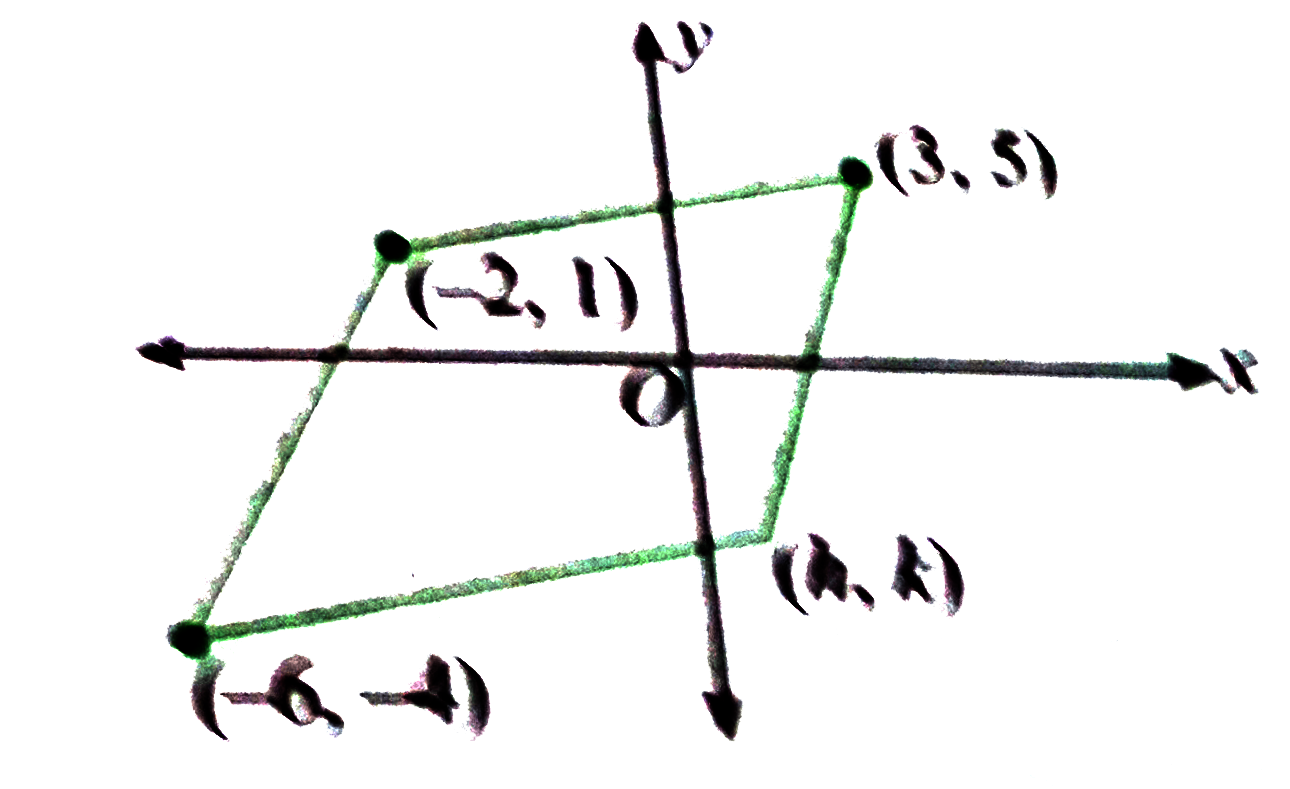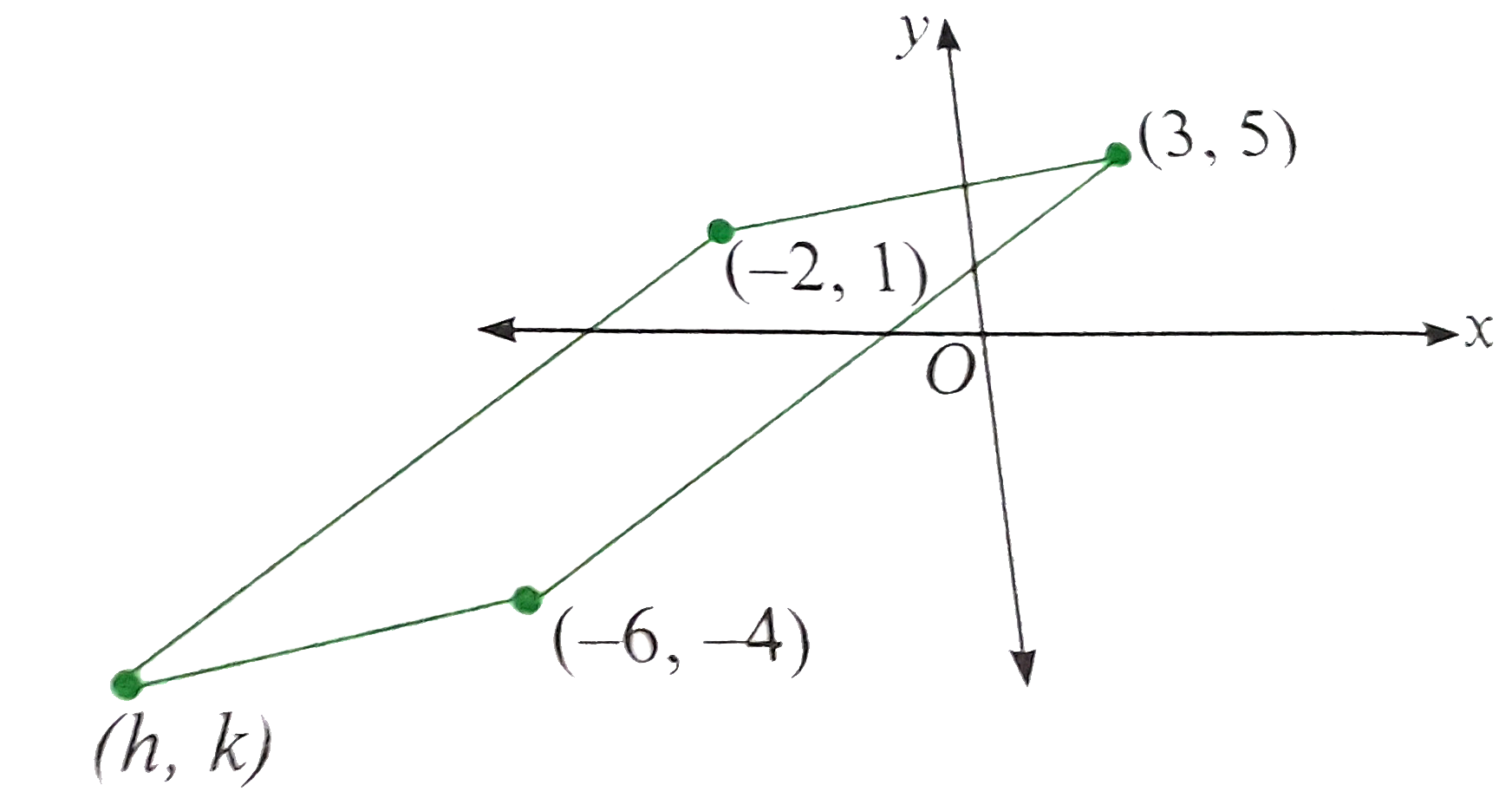If (−6,−4),(3,5),(−2,1) are the vertices of a parallelogram, then the remaining vertex can be (0,−1) (b) 7,9) (−1,0) (d) (−11,−8)Solution in Tamil
(0,−1)
(7,10)
(-1,0)
(−11,−8)
The correct Answer is:B, C, D
If the remaining vertex is (k,k) then

h−2=−6+3,k+1=5−4
or h=−1,k=0

h+3=−6,k+5=−4+1
or h=−11,k=−8

h−6=3−2,k−4=5+1
or h=7,k=10
Topper's Solved these Questions
- BOOK - CENGAGECHAPTER - COORDINATE SYSYEM EXERCISE - Exercise (Comprehension)10videos
COORDINATE SYSYEM
- BOOK - CENGAGECHAPTER - COORDINATE SYSYEM EXERCISE - Exercise (Matrix)4videos
COORDINATE SYSYEM
- BOOK - CENGAGECHAPTER - COORDINATE SYSYEM EXERCISE - Exercise (Single)59videos
COORDINATE SYSYEM
- BOOK - CENGAGECHAPTER - COORDINATE SYSTEMEXERCISE - Multiple Correct Answers Type2videos
COORDINATE SYSTEM
- BOOK - CENGAGECHAPTER - CROSS PRODUCTS EXERCISE - DPP 2.213videos
CROSS PRODUCTS
Similar Questions
Study the diagram. The line l is perpendicular to line m Does PE bisect CG?
02:33View SolutionConsider the triangle whose vertices are (-1,0),(5,-2) and (8,2). Find the centroid of the triangle.
03:14View SolutionABC is an isosceles triangle. If the coordinates of the base are B(1,3) and C(−2,7) , the coordinates of vertex A can be (a)(1,6) (b) (−12,5) (c)(56,6) (d) none of these
03:02View SolutionCoordinates of points on curve 5x2−6xy+5y2−4=0 which are nearest to origin are
02:05View SolutionLet →a and →b be two vectors of equal magnitude 5 units. Let →p,→q be vectors such that →p=→a−→b and →q=→a+→b. If |→p×→q|=2{λ−(→a.→b)2}12, then value of λ is
04:11View SolutionIf (−6,−4),(3,5),(−2,1) are the vertices of a parallelogram, then the remaining vertex can be (a)(0,−1) (b) 7,9) (c)(−1,0) (d) (−11,−8)
06:42View SolutionThree vertices of a parallelogram are (1, 1), (2, 4) and (3,5), then the fourth vertex of the parallelogram can be:
04:58View SolutionIf (−6,−4),(3,5),(−2,1) are the vetices of a prallelogram. Then the remaining vertex can be
03:04View SolutionThree vertices of a parallelogram are (0, 0, 0), (2, -1, 2) and (5, 6, 8) Find the coordinates of
the Fourth vertex.03:21View SolutionIf (-6, -4), (3, 5), (-2, 1) are the vertices of a parallelogram, then remaining vertex can be
02:09View Solutionसमांतर चतुर्भुज ABCD के तीन शीर्ष B(6, 7), C(8, 3) और D(0, -1) हैं । शीर्ष A के निर्देशांक ज्ञात कीजिए ।
06:08View Solutionयदि समान्तर चतुर्भुज ABCD के शीर्षों के निर्देशांक A (3 , 4 , -1) , B ( 7 , 10 , -3) और C (8 , 1, 0) हों तो चौथे शीर्ष D के निर्देशांक ज्ञात कीजिए ।
06:46View SolutionThe fourth vertex of a parallelogram,whose consecutive vertices are (3,−4),(−2,1)and(-6,5) is
03:14View SolutionIf (−6,−4) and (3,5) are the extremities of the diagonal of a parallelogram and (−2,1) is its third vertex , then its fourth vertex is
04:38View SolutionThe points (-1, 0) and (-2, 1) are two vertices of a diagonal of a parallelogram. If (-6, 5) is the third vertex, then the fourth vertex of the parallelogram will be
02:47View SolutionIf (−6,−4),(3,5),(−2,1) are the vertices of a parallelogram, then the remaining vertex can be (a)(0,−1) (b) 7,9) (c)(−1,0) (d) (−11,−8)
06:40View Solution

